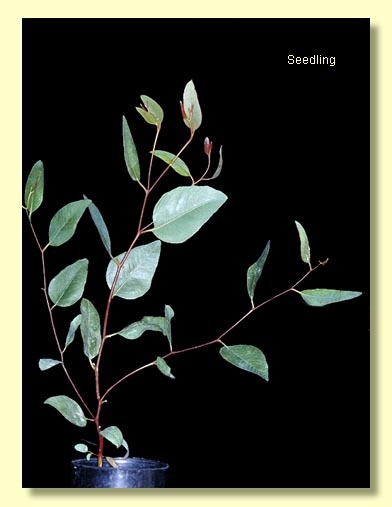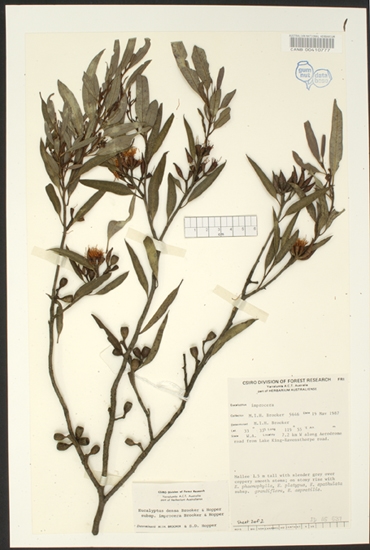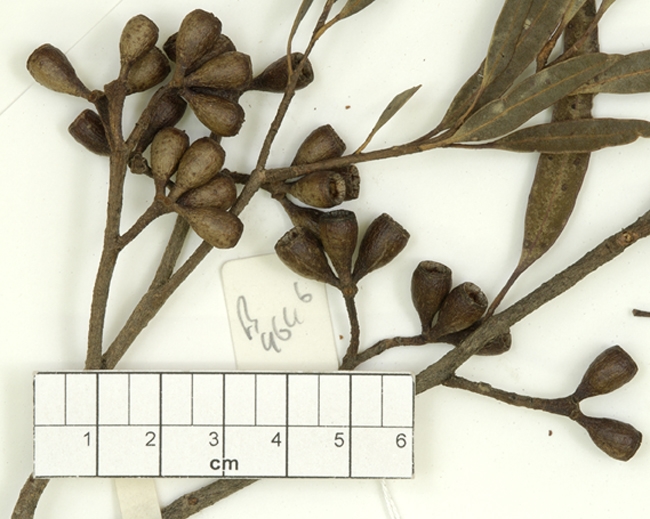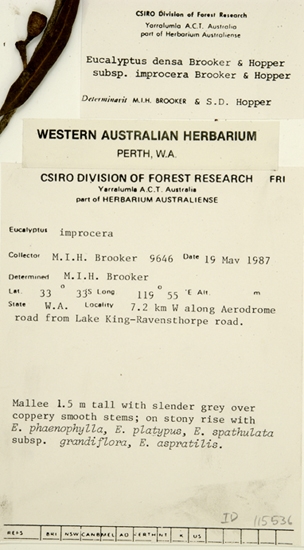Eucalyptus | Symphyomyrtus | Bisectae | Glandulosae | Levispermae | Levispermae
Euclid - Online edition
Eucalyptus densa subsp. improcera
Low shrubby mallee to 3 m tall. Forming a lignotuber.
Bark smooth throughout, grey over pale coppery and brown.
Branchlets lacking oil glands in the pith.
Juvenile growth (coppice or field seedlings to 50 cm): not seen.
Adult leaves alternate, petioles 0.5–1.2; blade linear to narrowly lanceolate, 4.7–8.2 cm long, 0.5–1 cm wide, base tapering to petiole, margin entire, apex pointed, concolorous, dull, grey to grey-green, side-veins greater than 45° to midrib, reticulation obscure or sparse to moderate, intramarginal vein present or obscure, oil glands island and intersectional.
Inflorescence axillary unbranched, peduncles widening apically, 0.8–1.5 cm long, buds 9 or 11 per umbel, pedicellate (pedicels 0.3–0.9 cm long). Mature buds long-fusiform (1.5–2.5 cm long, 0.3–0.4 cm wide), scar present, operculum horn-shaped, about three to four times as long as the hypanthium and equal to it in width at the join, few outer stamens erect, most stamens variably deflexed, anthers oblong, versatile, dorsifixed, dehiscing by longitudinal slits, style long and straight, stigma blunt to tapered, locules 3, the placentae each with 4 vertical rows of ovules. Flowers lemon.
Fruit pedicellate (pedicels 0.1–0.6 cm long), cylindrical to barrel-shaped or obconical, 0.8–1.2 cm long, 0.5–0.7 cm wide, disc descending vertically, valves 3, at rim level or sometimes enclosed.
Seeds pale brown or straw-coloured, 0.7–1.3 mm long, sub-spherical, surface smooth, hilum ventral/terminal.
Cultivated seedlings (measured at ca node 10): cotyledons Y-shaped (bisected); stems rounded in cross-section; leaves always petiolate, opposite for ca 3 nodes then alternate, lanceolate to ovate, 5–8.5 cm long, 0.8–3(4) cm wide, dull green.
Flowering has been recorded in April, May, August and November.
Eucalyptus densa is a species with erect mallet or low shrubby mallee habit, endemic to Western Australia, of subcoastal distribution from about Ongerup and Pingrup in the west to just north-east of Esperance, extending inland into drier country north-west of Hyden and the Bremer Range. The bark is smooth and the adult leaves dull blue-green.
It is a somewhat anomalous species in Eucalyptus subgenus Symphyomyrtus section Bisectae subsection Glandulosae because whilst the cotyledons are bisected and the buds have an operculum scar, as do other species in this group, the branchlets lack the characteristic pith oil glands. Within this subsection E. densa is one of a group of species that form series Levispermae subseries Levispermae characterised by having smooth spherical seed, a peduncle that widens apically, buds that are narrowly fusiform with some stamens erect and others variably deflexed and usually dull blue-grey to grey-green adult leaves.
E. densa is most closely related to the taller mallet E. gardneri but differs in having smaller adult leaves that are never more than 1 cm wide, and a very dense crown. In addition E. gardneri usually has persistent curls or flakes of bark on the trunks; E. densa has smooth trunks which sheds in curly flakes. E. densa is also closely related to the smooth-barked, bluish-leaved mallee E. pluricaulis, but again differs in having much smaller leaves. Another closely related species is the mallet E. clivicola which has conspicuously glossy green adult leaves.
There are two subspecies:
E. densa subsp. densa
An erect mallet with leaves in a dense terminal crown. The habitat is variable from lateritic breakaways to heavy-soiled depressions. This is a popular small tree in municipal and domestic gardens because it branches low, has a dense crown of narrow leaves and lovely lemon or pale yellow flowers which are highly attractive to honeyeaters.
E. densa subsp. improcera
A low shrubby mallee with wide spreading branchlets to the ground. The habitat is yellow sandplain north-west of Ravensthorpe to south of Jerramungup.
subsp. improcera: Latin improcerus, short, undersized, referring to the habit.


















